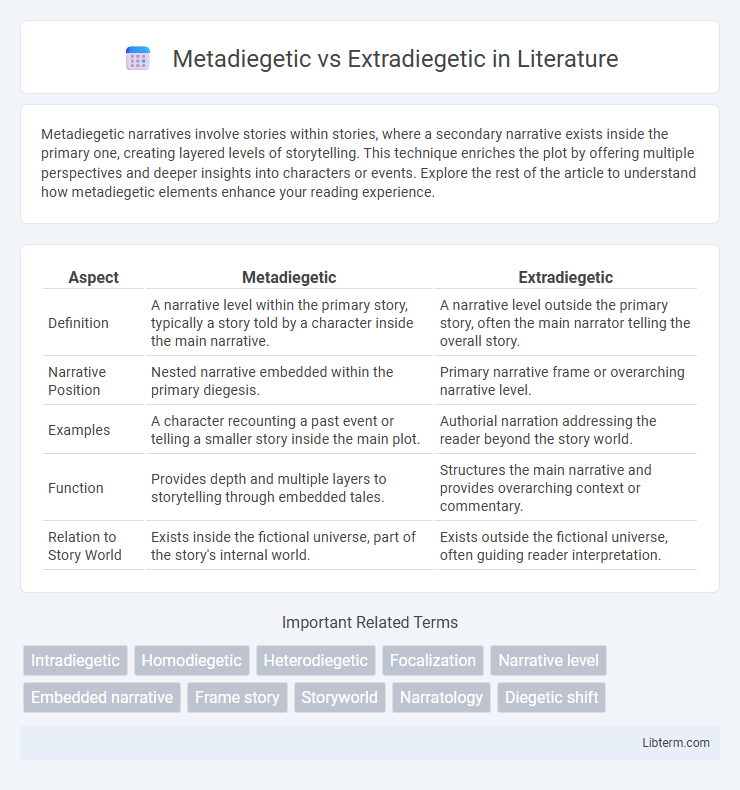Metadiegetic narratives involve stories within stories, where a secondary narrative exists inside the primary one, creating layered levels of storytelling. This technique enriches the plot by offering multiple perspectives and deeper insights into characters or events. Explore the rest of the article to understand how metadiegetic elements enhance your reading experience.
Table of Comparison
| Aspect | Metadiegetic | Extradiegetic |
|---|---|---|
| Definition | A narrative level within the primary story, typically a story told by a character inside the main narrative. | A narrative level outside the primary story, often the main narrator telling the overall story. |
| Narrative Position | Nested narrative embedded within the primary diegesis. | Primary narrative frame or overarching narrative level. |
| Examples | A character recounting a past event or telling a smaller story inside the main plot. | Authorial narration addressing the reader beyond the story world. |
| Function | Provides depth and multiple layers to storytelling through embedded tales. | Structures the main narrative and provides overarching context or commentary. |
| Relation to Story World | Exists inside the fictional universe, part of the story's internal world. | Exists outside the fictional universe, often guiding reader interpretation. |
Introduction to Narrative Levels
Metadiegetic and extradiegetic narrators represent different narrative levels within storytelling structures, with extradiegetic narrators existing outside the primary story world and metadiegetic narrators embedded within a secondary narrative or story within a story. The concept of extradiegetic narrative level refers to the overarching narratorial perspective that guides the entire story, while metadiegetic narrative level involves a subordinate narrative layer where a character within the primary story recounts another tale. Understanding these distinctions enhances comprehension of complex narrative techniques used in literature and film to create multi-layered storytelling effects.
Defining Metadiegetic Narration
Metadiegetic narration refers to a secondary narrative embedded within the primary story, where a character inside the main narrative recounts another tale. This layer of storytelling creates a narrative within the narrative, often providing deeper insight or alternative perspectives. The distinction from extradiegetic narration lies in the narrator's position; metadiegetic narrators exist within the fictional world, while extradiegetic narrators stand outside the narrative framework.
Understanding Extradiegetic Narration
Extradiegetic narration occurs when the narrator exists outside the story world, often providing an all-knowing perspective that guides the audience without being a character in the plot. This narrative level contrasts with metadiegetic narration, where the narrator is embedded within the story, often recounting events to other characters. Understanding extradiegetic narration is crucial for analyzing narrative distance and how storytellers control information flow and audience perception.
Key Differences Between Metadiegetic and Extradiegetic
Metadiegetic narration occurs within a story embedded inside the primary narrative, where the narrator recounts events from a secondary fictional layer. Extradiegetic narration takes place outside the story world, with a narrator who exists beyond the narrative frame and directly addresses the audience. The key difference lies in their narrative position: metadiegetic narrators operate inside the diegetic levels of the story, while extradiegetic narrators maintain an external, overarching perspective.
Functions of Metadiegetic Narratives in Literature
Metadiegetic narratives function as embedded stories within the main narrative, offering deeper insight into characters' psyches and enriching the thematic complexity of the text. They create layers of storytelling that challenge readers' perception of reality and fiction, often revealing biases or unreliabilities in primary narrators. By providing alternative perspectives, metadiegetic narratives enhance narrative depth and contribute to the exploration of metafictional elements in literature.
The Role of Extradiegetic Narrators
Extradiegetic narrators operate outside the story's world, providing an overarching viewpoint that shapes the audience's understanding without participating in the narrative events. Their role includes offering context, commentary, and insights that the characters themselves may not be aware of, enhancing thematic depth and guiding interpretation. This narrative position creates a distinct layer of storytelling, separating the narrator's voice from the diegetic reality experienced by characters.
Examples of Metadiegetic Narratives
Metadiegetic narratives occur when a story is embedded within another story, such as a character recounting a past event or a tale within a tale, exemplified by the storytelling structure in "One Thousand and One Nights" where Scheherazade narrates multiple nested stories. Another notable example is in "Heart of Darkness" by Joseph Conrad, where Marlow narrates his journey, and within that, he recounts his encounter with Kurtz, creating layers of narrative levels. These metadiegetic layers enrich storytelling by providing depth and complexity through nested perspectives.
Examples of Extradiegetic Narratives
Extradiegetic narratives occur when the narrator exists outside the story's world, offering an external perspective that guides the audience through the plot, as seen in classic novels like Charles Dickens' "Great Expectations" and films such as Alfred Hitchcock's "Psycho." These narrators do not participate in the events they describe but provide commentary or insights, exemplified by the omniscient narrator in Jane Austen's "Pride and Prejudice" or the voice-over in "The Shawshank Redemption." Extradiegetic narration enhances storytelling by adding layers of interpretation and context beyond the characters' experiences.
Impact on Reader Perception and Engagement
Metadiegetic narration, where a story is told within another story, creates layers that encourage deeper reader engagement by stimulating curiosity and analytical thinking. Extradiegetic narration, positioned outside the story world, maintains a clear narrative boundary, fostering straightforward comprehension and emotional connection with the main plot. The impact on reader perception varies as metadiegetic structures invite active interpretation, while extradiegetic approaches provide authoritative guidance, shaping the reader's immersion and response.
Conclusion: Narrative Complexity and Storytelling
Metadiegetic and extradiegetic narrative levels enrich storytelling by layering perspectives and expanding temporal boundaries, enhancing narrative complexity. Metadiegetic narratives involve stories within stories, offering internal perspectives that deepen character development and thematic exploration. Extradiegetic narration operates outside the story world, providing an overarching viewpoint that guides audience interpretation and frames the narrative's meaning.
Metadiegetic Infographic

 libterm.com
libterm.com